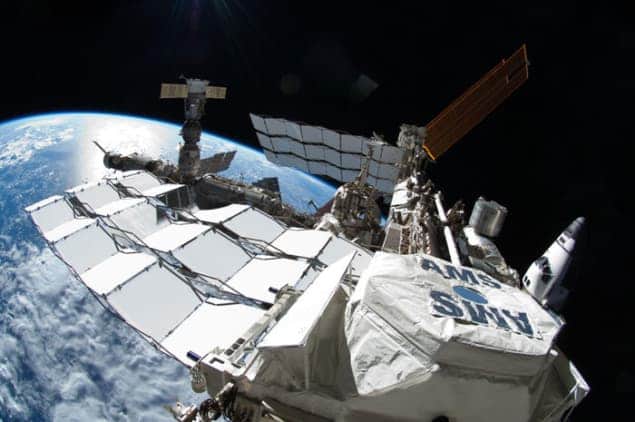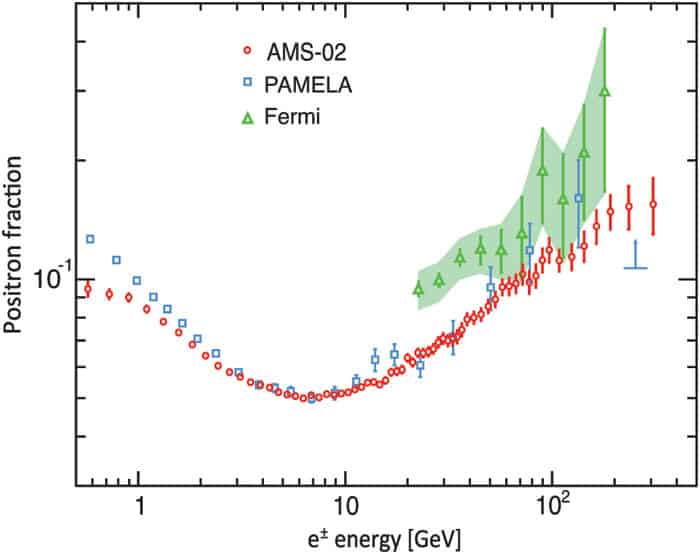
The international team running the $1.5bn Alpha Magnetic Spectrometer (AMS) has announced it has seen an excess of positrons at high energies that could point the way towards a possible detection of dark matter. Speaking at CERN yesterday, AMS principal investigator Samuel Ting presented the first results from the space-based observatory, adding that the positron excess may originate from dark matter or could be from a more benign source, such as pulsars.
The AMS sits on the International Space Station (ISS) and is designed to study high-energy particles – or cosmic rays – before they have a chance to interact with the Earth’s atmosphere. Weighing 7.5 tonnes, the AMS detector uses a 0.15 T cylindrical magnet 1 m in diameter and 1 m in height to sort incoming particles according to their momentum and charge. The direction of bend of the particle tracks through the magnet’s bore depends on whether the particles are matter or antimatter, while the gradient of the bend is determined by their speed. This allows the detector to distinguish between vast numbers of different types of cosmic-ray particles.
The AMS searches for an excess of charged particles such as positrons in an energy range from 500 MeV to 1 TeV. It studies the ratio of positrons to electrons – “the positron fraction” – over this entire range looking for any excess that could point to the evidence of dark-matter annihilation. This could be caused, for example, by the presence of WIMPs – leading candidates for dark matter – or other candidate particles that are colliding with each other and emitting the charged particles.
Excess events
In 2008 the Italian-led Payload for Antimatter Matter Exploration and Light-nuclei Astrophysics (PAMELA) mission gathered tentative evidence of an excess of positrons at energies of up to 100 GeV – positrons that could have been produced by the annihilation of dark-matter particles. According to standard theory, the positron fraction should fall off with increasing energy. The PAMELA results, however, were not watertight, mainly because of the possibility that the mission was confusing positrons with the far larger numbers of protons reaching its detectors.
Then in 2011 NASA’s Fermi Gamma-Ray Space Telescope supported PAMELA’s findings and confirmed a larger-than-expected rate of high-energy positrons reaching the Earth from outer space. Although Fermi is a gamma-ray telescope, the probe works by detecting electron–positron pairs and so is also well suited to studying cosmic rays.
Detecting antimatter
Presenting the results to a packed auditorium at CERN yesterday, Ting says that the AMS has so far collected around 18 months’ worth of data – around 10% of the amount it expects to collect over its 20-year lifetime. The AMS has collected 25 billion events to date, of which 6.8 million were identified as electrons and positrons. Of these 6.8 million events, around 400,000 are positrons with energies between 0.5 GeV and 350 GeV – the largest number of antimatter particles directly measured and analysed from space.
The positron fraction as measured by the AMS shows a decrease from 1 to 10 GeV but then increases from 10 to 250 GeV. Ting, who works at the Massachusetts Institute of Technology, adds that the data also indicate no sharp peaks or significant variation over time, or any preferred incoming direction. Assuming an isotropic distribution of dark-matter particles, the results are consistent with positrons originating from the annihilation of WIMPs in space.

“The results show how precise our detector is in measuring very weak effects, like the behaviour of the positron ratio at high energy,” AMS deputy spokesperson Roberto Battiston from the University of Trento in Italy told physicsworld.com. “Collecting more statistics at higher energy will likely shed light on the origin of the source of positron excess.”
“It is quite impressive and the agreement with the earlier PAMELA results is excellent – a tribute to the hard work of the PAMELA team that had a much smaller instrument with a less intense magnetic field in a different orbit around the Earth,” says astrophysicist John Wefel from Louisiana State University.
‘Beautiful results’
However, the AMS measurements cannot yet rule out alternative explanations, such as the positrons originating from pulsars. Supersymmetry theories predict a cut-off at higher energies above the mass range of dark-matter particles, and this has not yet been observed.
“Astrophysics is very good at making positrons and the rise could be due to astrophysics we don’t yet understand, rather than dark matter annihilations,” says Michael Turner from the University of Chicago. Turner, who calls the AMS results “beautiful”, adds that the WIMP hypothesis fits the data, “but as Carl Sagan taught, extraordinary claims require extraordinary evidence and we are not there yet”.
Ting adds that over the next few years, the collaboration will further refine the measurement and attempt to clarify the behaviour of the positron fraction at energies above 250 GeV. Indeed, the positron fraction already indicates a levelling off above 250 GeV, hinting that a drop off could be in sight. “We have a feeling what is happening, but it is too early to discuss this,” says Ting.
“As to the question uppermost in everyone’s mind – do the measurements indicate dark matter? – unfortunately the answer is yes, no and maybe,” adds Wefel. “Whether [the levelling off] is physics or statistics or instrumental cannot be determined without more data. We just have to stay tuned and be patient.”
The rocky road to the ISS
Ting, who shared the 1976 Nobel Prize for Physics with Burton Richter for the discovery of the J/ψ particle, has built up a collaboration of some 600 physicists from 60 institutes in 16 countries who work on the AMS.
The AMS was first proposed by Ting in the 1990s after he failed to get support for a couple of ground-based particle experiments – a detector for the ultimately doomed Superconducting Super Collider and an upgrade of the L3 experiment at CERN near Geneva.
Ting’s idea to put a detector in space was fortuitous, given that the then administrator of NASA, Dan Goldin, was keen to give the ISS some scientific credibility. In 1995, following a positive review of the AMS by the US Department of Energy, Ting secured a space-shuttle flight from Goldin and then set about obtaining funding from mainly European governments. The AMS team concluded that the detector was simply too heavy and too power hungry to be put into orbit on its own dedicated satellite.
However, the AMS was delayed following the Columbia Space Shuttle disaster in 2003, with NASA deciding that all subsequent space-shuttle flights should be devoted to completing the ISS. In 2008 Congress then approved legislation for an additional, dedicated flight to take the AMS to the ISS. The AMS was finally lifted into orbit on board the Space Shuttle Endeavour in May 2011.
The research is published in Physical Review Letters.



